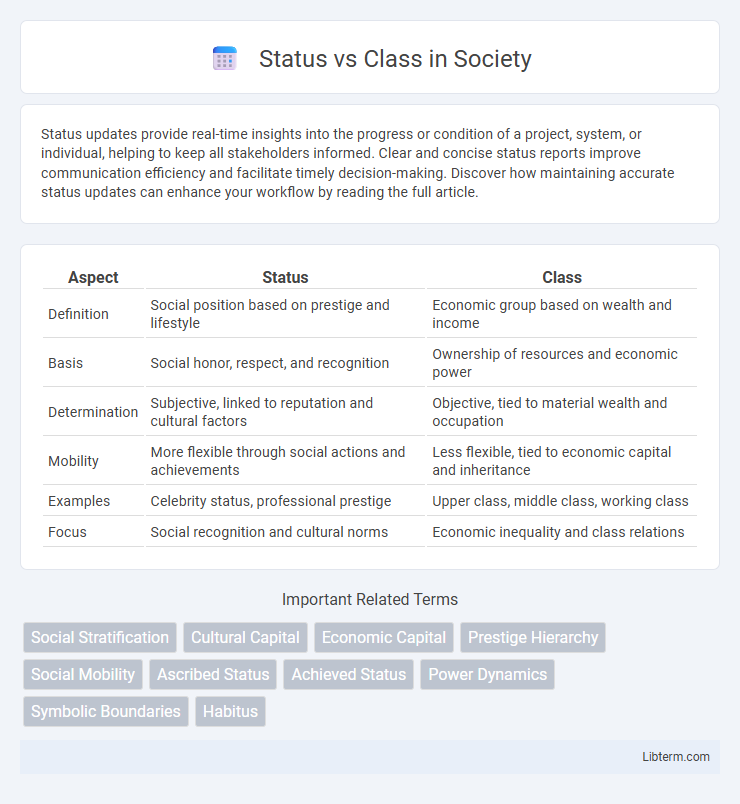Status updates provide real-time insights into the progress or condition of a project, system, or individual, helping to keep all stakeholders informed. Clear and concise status reports improve communication efficiency and facilitate timely decision-making. Discover how maintaining accurate status updates can enhance your workflow by reading the full article.
Table of Comparison
| Aspect | Status | Class |
|---|---|---|
| Definition | Social position based on prestige and lifestyle | Economic group based on wealth and income |
| Basis | Social honor, respect, and recognition | Ownership of resources and economic power |
| Determination | Subjective, linked to reputation and cultural factors | Objective, tied to material wealth and occupation |
| Mobility | More flexible through social actions and achievements | Less flexible, tied to economic capital and inheritance |
| Examples | Celebrity status, professional prestige | Upper class, middle class, working class |
| Focus | Social recognition and cultural norms | Economic inequality and class relations |
Understanding the Concepts: Status vs Class
Status and class represent distinct sociological concepts that describe an individual's position within society. Status refers to the social honor or prestige tied to specific roles and identities, often influenced by cultural norms, while class primarily addresses economic factors such as income, wealth, and occupation. Understanding the difference between status and class is crucial for analyzing social stratification and mobility, as status emphasizes social recognition whereas class highlights material conditions.
Historical Evolution of Class and Status
The historical evolution of class and status reveals distinct yet interconnected social dimensions, with class rooted in economic factors such as wealth, occupation, and access to resources, while status derives from social honor, prestige, and lifestyle. Throughout history, class structures were primarily shaped by industrialization and capitalism, creating clear divisions between working, middle, and upper classes, whereas status was influenced by cultural traditions, education, and social norms. Sociologists like Max Weber emphasized how class relates to economic power and status to social prestige, highlighting that these concepts evolved differently across societies but collectively structure social stratification.
Key Differences Between Status and Class
Status refers to an individual's social position based on factors like prestige, reputation, or honor, which can be achieved or ascribed, while class primarily relates to economic standing determined by income, wealth, and occupation. Status often influences social interactions and recognition within a community, whereas class shapes access to resources, opportunities, and lifestyle choices. Understanding the distinction helps analyze social dynamics, as status may cross class boundaries but class usually defines material conditions and power structures.
How Status Influences Social Interactions
Status shapes social interactions by dictating expected behaviors and social roles within a group, influencing how individuals are perceived and treated. High-status individuals often receive deference and greater influence, while low-status members may face exclusion or marginalization. These status-driven dynamics affect communication patterns, access to resources, and opportunities for social mobility.
The Role of Class in Economic Mobility
Class significantly influences economic mobility by determining access to resources such as quality education, professional networks, and capital. Those in higher social classes benefit from inherited wealth and social connections that facilitate upward mobility, while lower classes often face systemic barriers limiting economic advancement. Understanding class dynamics is crucial for analyzing persistent inequalities and crafting policies aimed at promoting equitable opportunities.
Status Symbols: Indicators and Implications
Status symbols serve as visible indicators of an individual's social standing, often manifested through luxury goods like designer clothing, high-end cars, and prestigious real estate. These symbols not only communicate wealth but also reinforce social hierarchy and group identity within various class structures. The implications of status symbols extend to consumer behavior, social mobility perceptions, and cultural capital, highlighting their role in both personal identity and societal dynamics.
Intersection of Class and Status in Modern Society
The intersection of class and status in modern society reveals how socioeconomic position and social prestige jointly influence individual opportunities and social mobility. While class primarily reflects economic resources and occupational roles, status encompasses social honor and lifestyle distinctions that often transcend income levels. This dynamic interaction shapes access to education, networks, and cultural capital, reinforcing social stratification and perpetuating inequalities.
Cultural Perceptions: Status vs Class Across Societies
Cultural perceptions of status and class vary significantly across societies, shaping social interactions and hierarchy. Status often reflects an individual's prestige or honor gained through achievements, while class typically denotes inherited socioeconomic positions tied to wealth or occupation. In collectivist cultures, status may emphasize respect and social harmony, whereas in individualist societies, class distinctions often highlight economic power and social mobility.
Impact of Status and Class on Identity Formation
Status and class significantly shape identity formation by influencing access to resources, social networks, and cultural capital. Higher social class often provides individuals with greater opportunities for education and career advancement, fostering a sense of confidence and social belonging. In contrast, lower status can lead to experiences of marginalization, impacting self-perception and social identity development.
Bridging the Gap: Moving Beyond Status and Class Divisions
Bridging the gap between status and class divisions requires redefining social mobility through inclusive policies that emphasize equal opportunities in education, employment, and wealth distribution. Addressing systemic inequalities involves dismantling entrenched barriers that perpetuate privilege based on inherited class and perceived social status. Embracing social cohesion strategies fosters environments where merit and capability take precedence over traditional hierarchies, enabling more equitable economic and societal outcomes.
Status Infographic

 libterm.com
libterm.com